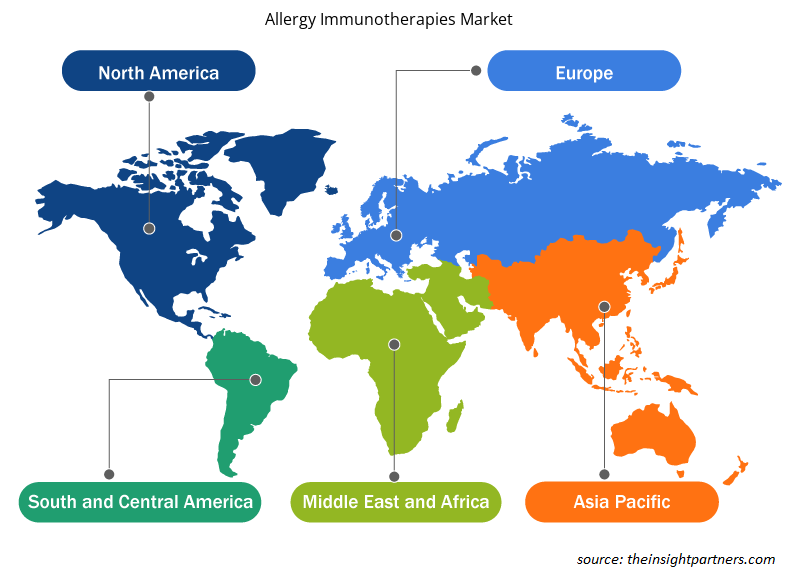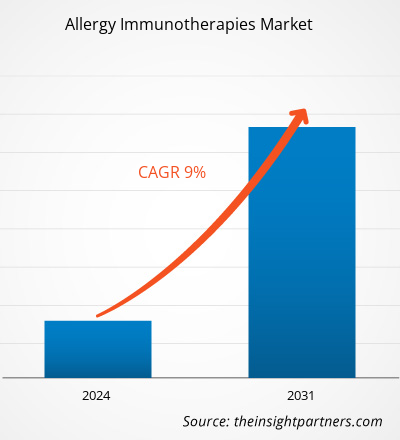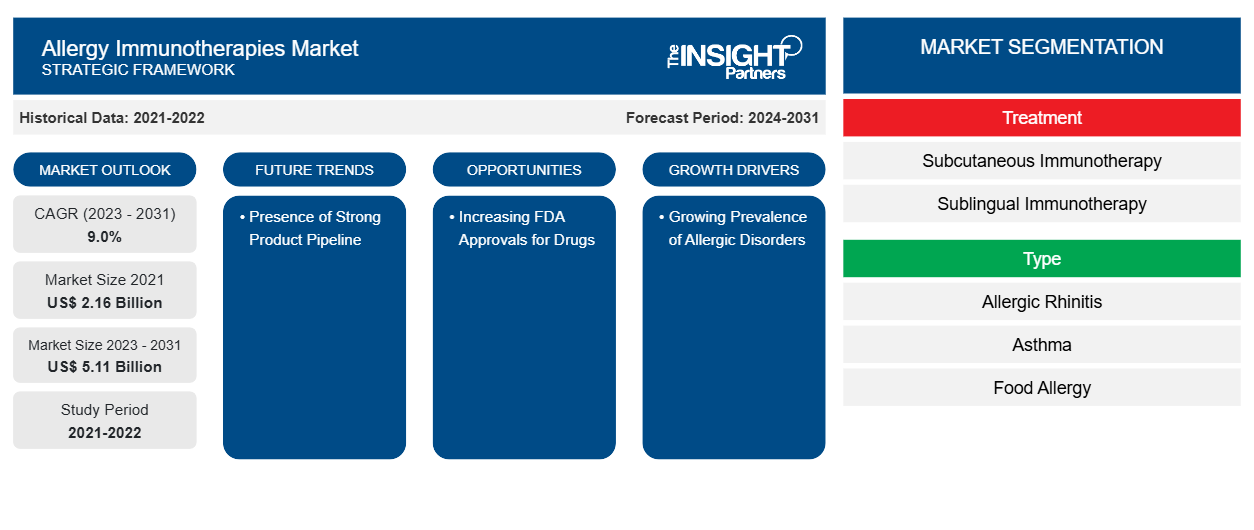Il mercato delle immunoterapie allergiche è stato stimato in 2,16 miliardi di dollari USA nel 2021 e xx miliardi di dollari USA nel 2023. Si prevede che raggiungerà i 5,11 miliardi di dollari USA entro il 2031 e registrerà un CAGR del 9,0% fino al 2031. Lo sviluppo di nuovi metodi di somministrazione, l'aumento delle terapie combinate, i progressi nella medicina personalizzata rimarranno probabilmente le tendenze chiave del mercato delle immunoterapie allergiche.immunotherapies market was estimated to be US$ 2.16 Bn in 2021 and US$ xx Bn in 2023. It is expected to reach US$ 5.11 Bn by 2031 and record a CAGR of 9.0% until 2031. Development of new delivery methods, rise of combination therapies, advancements in personalised medicine will likely remain key allergy immunotherapies market trends.
Analisi di mercato delle immunoterapie allergicheImmunotherapies Market Analysis
Si prevede che la crescente prevalenza di disturbi allergici in tutto il mondo guiderà la crescita del mercato delle immunoterapie allergiche. La crescente prevalenza di disturbi allergici richiede l'immunoterapia allergica, che è un trattamento sicuro ed efficace contro allergeni come muffe di insetti, pollini e animali, nonché per l'asma allergico. Secondo l'American College of Allergy, Asthma & Immunology, nel 2021, 1 adulto su 3 e oltre 1 bambino su 4 negli Stati Uniti hanno riferito di avere un'allergia stagionale, un eczema o un'allergia alimentare.
La crescente prevalenza delle allergie in tutto il mondo sta aumentando la domanda globale di immunoterapie, favorendo la crescita del mercato.
Panoramica del mercato delle immunoterapie allergiche
Il mercato globale delle immunoterapie allergiche è segmentato per regione in Nord America, Europa, Asia Pacifico, Medio Oriente e Africa e Sud e Centro America. La crescita del mercato in questa regione è prevista a causa di fattori quali la crescente prevalenza di disturbi allergici e i progressi tecnologici nelle formulazioni di dosaggio sublinguale. Tuttavia, gli svantaggi associati all'uso di immunoterapie allergiche e le variazioni normative tra le regioni probabilmente ostacoleranno la crescita del mercato durante il periodo di previsione.
Personalizza questo report in base alle tue esigenze
Riceverai la personalizzazione gratuita di qualsiasi report, comprese parti di questo report, o analisi a livello nazionale, pacchetto dati Excel, oltre a usufruire di grandi offerte e sconti per start-up e università
-
Scopri le principali tendenze di mercato in questo rapporto.Questo campione GRATUITO includerà analisi di dati che spaziano dalle tendenze di mercato alle stime e alle previsioni.
Driver e opportunità del mercato delle immunoterapie allergiche
La crescente consapevolezza del trattamento delle allergie favorirà probabilmente il mercato.
Una maggiore consapevolezza pubblica sulle allergie e sulle loro opzioni di gestione alimenta la domanda di trattamenti migliori. Le persone cercano sollievo dai sintomi che possono avere un impatto significativo sulla loro qualità di vita.
L'Office of the State Superintendent of Education (OSSE) e la Division of Health & Wellness hanno celebrato la Food Allergy Awareness Week dal 14 al 20 maggio 2023. La campagna si è concentrata sull'educazione e sulla sensibilizzazione sulle allergie alimentari e sull'anafilassi.OSSE) and the Division of Health & Wellness celebrated Food Allergy Awareness Week from May 14 to May 20, 2023. The campaign focused on educating and raising awareness about food allergies and anaphylaxis.
Presenza di una solida pipeline di prodotti: un'opportunità nel mercato delle immunoterapie allergicheImmunotherapies Market
La pipeline di immunoterapia allergica è composta da 15 terapie in diverse fasi cliniche di sviluppo. Alcuni degli attori coinvolti nello sviluppo di immunoterapie per le malattie allergiche sono Aimmune Therapeutics Inc., DBV Technologies SA, Genentech Inc., ASIT biotech SA, Inmunotek SL, Anergis SA, Biomay AG e Regeneron Pharmaceuticals Inc.immunotherapy pipeline consists of 15 therapies in different clinical stages of development. Some of the players involved in the development of immunotherapies for allergic diseases are Aimmune Therapeutics Inc., DBV Technologies S.A., Genentech Inc., ASIT biotech SA, Inmunotek SL, Anergis S.A., Biomay AG, and Regeneron Pharmaceuticals Inc.
I risultati clinici positivi di varie immunoterapie sottoposte a sperimentazioni cliniche supportano lo sviluppo di farmaci basati sull'immunoterapia allergica. Ad esempio, nel novembre 2022, la Food and Drug Administration (FDA) ha concesso la designazione Fast Track all'ADP101 di Alladapt Immunotherapeutic, un'immunoterapia orale sperimentale per il trattamento di uno o più degli allergeni alimentari più significativi.
Analisi della segmentazione del rapporto di mercato sulle immunoterapie allergiche
I segmenti chiave che hanno contribuito alla derivazione dell'analisi di mercato delle immunoterapie allergiche sono i servizi e le applicazioni.
- In base al trattamento, il mercato delle immunoterapie allergiche è segmentato in immunoterapia sottocutanea (SCIT) e immunoterapia sublinguale (SLIT). Nel 2023, il segmento dell'immunoterapia sottocutanea (SCIT) deteneva la quota maggiore del mercato. Inoltre, si prevede che il segmento dell'immunoterapia sublinguale (SLIT) crescerà al ritmo più rapido durante il periodo di previsione.
- In base al tipo di allergia, il mercato delle immunoterapie allergiche è segmentato in rinite allergica, asma, allergia alimentare, allergia al veleno e altri. Il segmento della rinite allergica ha detenuto la quota maggiore del mercato nel 2023 e si prevede che lo stesso segmento registrerà il CAGR più elevato nel mercato durante il periodo di previsione.
- Il mercato delle immunoterapie allergiche è stato segmentato per canale di distribuzione in farmacia ospedaliera, farmacia al dettaglio e farmacia online. Nel 2023, il segmento delle impostazioni della farmacia ospedaliera ha detenuto la quota maggiore del mercato per canale di distribuzione. Inoltre, si prevede che lo stesso segmento crescerà più rapidamente durante il periodo di previsione.
Analisi della quota di mercato delle immunoterapie allergiche per area geografica
L'ambito geografico del rapporto di mercato sulle immunoterapie allergiche è suddiviso principalmente in cinque regioni: Nord America, Asia Pacifico, Europa, Medio Oriente e Africa e Sud America/Sud e Centro America.
Il Nord America comprende Stati Uniti, Canada e Messico. Il Nord America detiene la quota più significativa nel mercato delle immunoterapie allergiche, con gli Stati Uniti che detengono la quota di mercato più grande, seguiti dal Canada. Gli Stati Uniti detengono la quota più grande del mercato delle immunoterapie allergiche attribuita alla crescente prevalenza di disturbi allergici, aumentando così la domanda di immunoterapia allergica e alimentando la crescita del mercato. Inoltre, è la sede centrale di molti produttori impegnati nella produzione di immunoterapia allergica, guidando ulteriormente la crescita del mercato nel paese. Inoltre, la crescente consapevolezza dei consumatori riguardo al trattamento delle allergie ha aumentato la domanda di ossigeno supplementare per la salute nel Nord America.
Si prevede che la regione Asia-Pacifico sarà la regione in più rapida crescita tra tutte le altre regioni. Si prevede che la crescita del mercato nella regione Asia-Pacifico crescerà a un ritmo più rapido a causa di fattori come l'elevata prevalenza di malattie allergiche e immunologiche in paesi come Australia, India e altri. Inoltre, si prevede che le crescenti iniziative adottate dal governo in termini di strategie di prevenzione e trattamento forniranno uno scenario di crescita del mercato redditizio nella regione. Inoltre, si prevede che lo sviluppo di infrastrutture sanitarie e l'aumento degli investimenti per potenziare le attività di ricerca guideranno il mercato delle immunoterapie allergiche dell'Asia-Pacifico durante il periodo di previsione.
Immunoterapie allergiche
Approfondimenti regionali sul mercato delle immunoterapie allergiche
Le tendenze regionali e i fattori che influenzano il mercato delle immunoterapie allergiche durante il periodo di previsione sono stati ampiamente spiegati dagli analisti di Insight Partners. Questa sezione discute anche i segmenti e la geografia del mercato delle immunoterapie allergiche in Nord America, Europa, Asia Pacifico, Medio Oriente e Africa e America meridionale e centrale.

- Ottieni i dati specifici regionali per il mercato delle immunoterapie allergiche
Ambito del rapporto di mercato sulle immunoterapie allergiche
| Attributo del report | Dettagli |
|---|---|
| Dimensioni del mercato nel 2021 | 2,16 miliardi di dollari USA |
| Dimensioni del mercato entro il 2031 | 5,11 miliardi di dollari USA |
| CAGR globale (2023-2031) | 9,0% |
| Dati storici | 2021-2022 |
| Periodo di previsione | 2024-2031 |
| Segmenti coperti |
Per trattamento
|
| Regioni e Paesi coperti |
America del Nord
|
| Leader di mercato e profili aziendali chiave |
|
Densità degli attori del mercato delle immunoterapie allergiche: comprendere il suo impatto sulle dinamiche aziendali
Il mercato delle immunoterapie allergiche sta crescendo rapidamente, spinto dalla crescente domanda degli utenti finali dovuta a fattori quali l'evoluzione delle preferenze dei consumatori, i progressi tecnologici e una maggiore consapevolezza dei benefici del prodotto. Con l'aumento della domanda, le aziende stanno ampliando le loro offerte, innovando per soddisfare le esigenze dei consumatori e capitalizzando sulle tendenze emergenti, il che alimenta ulteriormente la crescita del mercato.
La densità degli operatori di mercato si riferisce alla distribuzione di aziende o società che operano in un particolare mercato o settore. Indica quanti concorrenti (operatori di mercato) sono presenti in un dato spazio di mercato in relazione alle sue dimensioni o al valore di mercato totale.
Le principali aziende che operano nel mercato delle immunoterapie allergiche sono:
- ALK-Abelló A/S
- Scienza della Salute Nestlé
- FarmaciaLeti
- Stallergeni Greer
- Allergy BV è un'azienda farmaceutica che opera nel settore dell'allergia alimentare.
- Johnson and Johnson Services, Inc.
Disclaimer : le aziende elencate sopra non sono classificate secondo un ordine particolare.

- Ottieni una panoramica dei principali attori del mercato delle immunoterapie allergiche
Notizie di mercato e sviluppi recenti sulle immunoterapie allergiche
Il mercato delle immunoterapie allergiche viene valutato raccogliendo dati qualitativi e quantitativi post-ricerca primaria e secondaria, che includono importanti pubblicazioni aziendali, dati di associazioni e database. Di seguito è riportato un elenco degli sviluppi nel mercato delle immunoterapie allergiche e delle strategie:
- Ad agosto 2020, Nestlé Health Science ha acquisito Aimmune Therapeutics. La terapia approvata da Aimmune, Palforzia, amplierebbe il portafoglio di Nestlé Health Science con il primo e unico trattamento approvato dalla FDA per aiutare a ridurre la frequenza e la gravità delle reazioni allergiche alle arachidi nei bambini. (Fonte: comunicato stampa aziendale)
- Nel settembre 2023, Stallergenes Greer ha stipulato un accordo con Nestlé Health Science per sfruttare il trattamento immunoterapico orale per l'allergia alle arachidi Palforzia. (Fonte: comunicato stampa aziendale)
Copertura e risultati del rapporto di mercato sulle immunoterapie allergiche
Il rapporto "Dimensioni e previsioni del mercato delle immunoterapie allergiche (2021-2031)" fornisce un'analisi dettagliata del mercato che copre le seguenti aree:
- Dimensioni e previsioni del mercato a livello globale, regionale e nazionale per tutti i segmenti di mercato chiave coperti dall'ambito
- Dinamiche di mercato come fattori trainanti, vincoli e opportunità chiave
- Principali tendenze future
- Analisi dettagliata delle cinque forze PEST/Porter e SWOT
- Analisi di mercato globale e regionale che copre le principali tendenze di mercato, i principali attori, le normative e gli sviluppi recenti del mercato
- Analisi del panorama industriale e della concorrenza che copre la concentrazione del mercato, l'analisi della mappa di calore, i principali attori e gli sviluppi recenti
- Profili aziendali dettagliati
- Analisi storica (2 anni), anno base, previsione (7 anni) con CAGR
- Analisi PEST e SWOT
- Valore/volume delle dimensioni del mercato - Globale, Regionale, Nazionale
- Industria e panorama competitivo
- Set di dati Excel
Report recenti
Testimonianze
Motivo dell'acquisto
- Processo decisionale informato
- Comprensione delle dinamiche di mercato
- Analisi competitiva
- Analisi dei clienti
- Previsioni di mercato
- Mitigazione del rischio
- Pianificazione strategica
- Giustificazione degli investimenti
- Identificazione dei mercati emergenti
- Miglioramento delle strategie di marketing
- Aumento dell'efficienza operativa
- Allineamento alle tendenze normative























 Ottieni un campione gratuito per - Mercato delle immunoterapie allergiche
Ottieni un campione gratuito per - Mercato delle immunoterapie allergiche